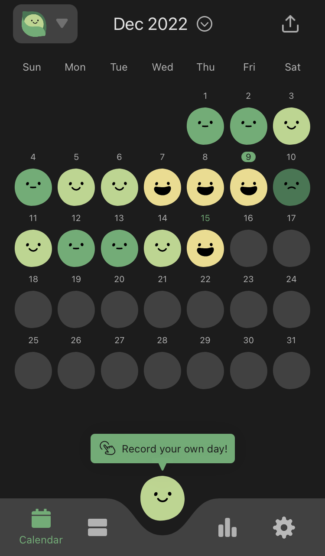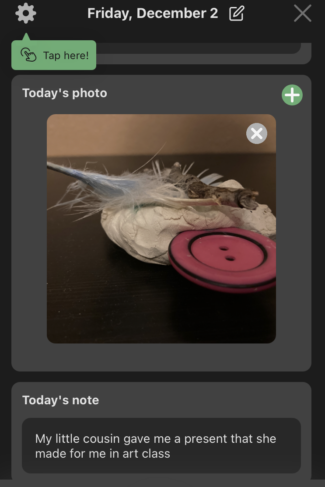Finch
LQ: 9.6
Recommended Age: 4+
Skills Used: Self-Awareness, Self-Control, Reading, Writing

 DailyBean is an app that allows the user to track their mood by clicking on different “bean emojis” each day that reflect different moods. When the user opens the app, they can click on the date on the calendar and then click on a range of emotions represented by the bean emojis. The user needs to select the emoji that they feel best represents their overall mood for the day. The bean will then pop up on the calendar so that the user can see how they were feeling each day in the month in one easy visual.
DailyBean is an app that allows the user to track their mood by clicking on different “bean emojis” each day that reflect different moods. When the user opens the app, they can click on the date on the calendar and then click on a range of emotions represented by the bean emojis. The user needs to select the emoji that they feel best represents their overall mood for the day. The bean will then pop up on the calendar so that the user can see how they were feeling each day in the month in one easy visual.
The user can stop there or choose to add additional information such as specific emotions they felt during the day, their sleep schedule, even a photo that they feel represents the day. Users can also backdate this information in the event that they miss a day and want to record. Users can also type in a short, diary-like entry to record context for why they were feeling that particular way.
After the user has made several entries, they can click on the statistics button, which can use graphs to see their moods, their sleep levels, and how often they selected specific emotions over time.
DailyBean is available on iOS and Android. It is a free to use app but some in-app purchases may be necessary to unlock features.
 Self-Awareness: Understanding our own actions, thoughts and feelings.
Self-Awareness: Understanding our own actions, thoughts and feelings.
Apps that track emotions like DailyBean can help the user practice their self-awareness skills. Because users can log their emotions everyday in varying levels of complexity, they are able to take a moment to reflect on their day and provide information on why they are feeling the way they feel. Some days the user may want to provide lots of information such as a diary entry, photo, and specific emotions. And some days they may just want to click on the bean emoji and leave it at that. But the process of sitting down to think about the general feeling of the day is an important step for the user to become more in-touch with their feelings.
Self-Control: Managing our actions, feelings and behaviors.
After the user has spent some time tracking their feelings using the DailyBean app, they can begin to look at the patterns of their emotions and see if they can identify certain triggers or situations that elicit certain emotions. For example, if the user notices that one week was all sad faces, they can look into their diary entries, or specific notes to see if there were similarities in each of those days. They can then begin to work on coming up with a plan for how to better handle those feelings or situations when they arise again. Similarly, if the user notices a lot of happy face beans, they can see what happened on those days and try to replicate the circumstances that led to those emotions.
All membership plans come with full access to our entire suite of tools learning guides, and resources. Here are a few of the ones we think you’ll like the most: